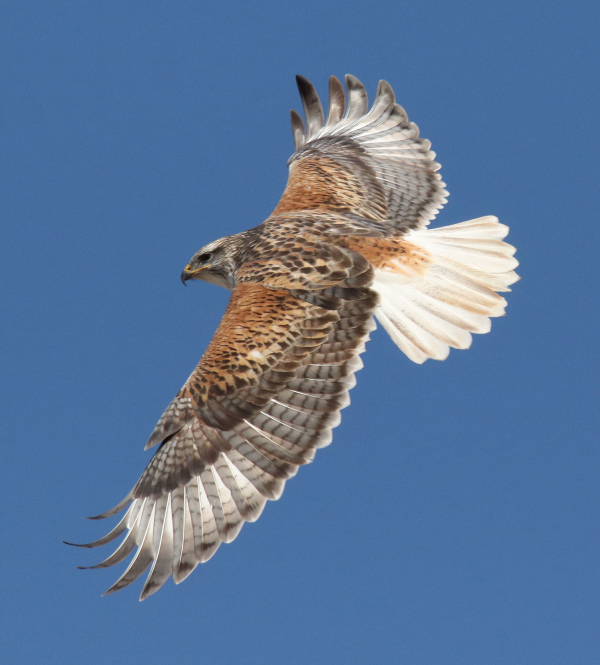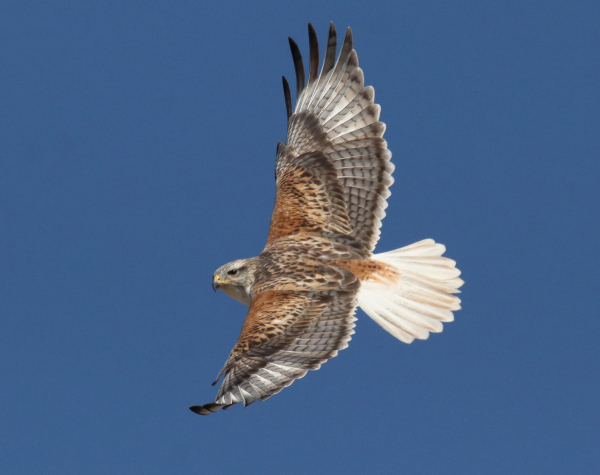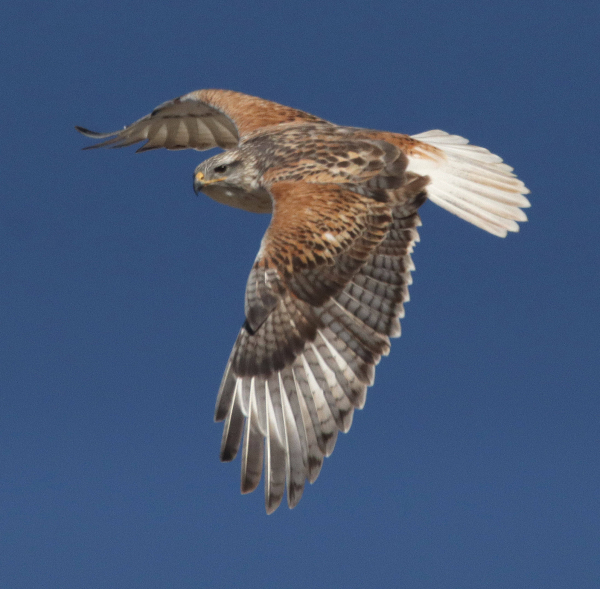On my way to check the status of the Bald Eagle stopover concentration I’ve been monitoring, it seemed I wasn’t yet fully awake as I drove past a familiar roadside stand of cottonwood trees 18 miles south of my office. Mostly hidden behind a large branch, I only had a glance at a Red-tail sized hawk. But even at 60 miles per hour, I could see the hawk had a white breast, neck, and light-gray head; and a sixth sense kicked in that flashed Ferruginous Hawk in my mind – hmm. I would need to get a second look at this bird and pulled into the next turnout to get a positive ID. As I reached for my binoculars the hawk flew low from the tree, showing its white tail and white gleam on the top of its wings – indeed, it was a Ferruginous Hawk!

After a concerning few moments of trying to get the hawk in focus, my auto-focus finally zeroed in on the Ferruginous flight just as it began to make a 180-degree turn into the bright morning sunlight (600mm zoom lens, f-9 aperture, 1/2000 shutter speed, 800 ISO.)
|
Now I was fully awake and the raptor had my full attention as it flew low into a stout west wind, alighting on a small hilltop that had a lip that probably offered something of a windbreak. It offered a poor photo option but there just happened to be a side road that permitted me to approach it slowly with the morning sunlight beaming in from behind me. I photographed the adult Ferrug as it stood on the ground among some tall dry plants, but in an instant it took flight toward the road, so I continued to take a couple photos until it passed before me. At that point I quickly jumped out of the car in a fashion that was somewhat stealthy.
In the meantime, the impressive white-tailed hawk elevated into the west wind above the road, where it was held almost motionless by the strong morning wind. The potential for a fine photo was there, but I had repeated trouble trying to find the hawk in my lens and focusing on it. I had to look away from my camera’s viewfinder to ascertain where the bird was positioned, then try to find it through my zoom lens, touch the shutter button to activate the autofocus 3 times before it finally zeroed in on the hawk – geez, that was a lot tougher than it shoulda been. I was awake, but my camera seemed to have some sleep in its eye yet – ha.

At that point I was thrilled to see the big hawk begin to turn in a half-circle, raising a wing to show its full wingspan and fully spread tail in the morning sunlight! My camera clicked as I took the first photo just as the Ferruginous Hawk was initiating the turn with its head partly lowered, but as it tipped its body toward me and raised its right wing in a classic slicing turn I pressed the shutter button down and held it there to let the ‘drive mode’ take over to take a continuous series of photos as the hawk caught the wind, turned with its wings sweeping downward, then spread its wings broadly as it leveled its body and wings – click, click, click, click – and then it flashed over my head and beyond. What a thrilling sequence!

A single sweep of its long wings anchored the orange hawk’s turn (ferruginous is a shade of orange) and throughout the hawk’s flight its widely spread, bright white tail signaled its identity to all who would witness its morning activities (600mm zoom lens, f-9 aperture, 1/4000 shutter speed, 800 ISO).
|
Yet the real thrill was reviewing the photos in the camera’s LCD screen and seeing the great potential that I had captured what would become a favorite photo sequence of a favorite bird. The photos looked great on a small scale, but the next question was: “Would the images hold up on the big screen of my computer?” The answer to that question would hafta wait as I resumed my drive to rendezvous with the concentration of Bald Eagles. When I did have the chance to view the images on my computer later that afternoon, I was astounded to see the vivid beauty of one photo in particular, and the sequence overall. Just as I appreciated this surprise opportunity, be prepared for your next bird photography encounter, and Good Luck!

Article and Photographs by Paul Konrad
Share your bird photos and birding experiences at editorstbw2@gmail.com